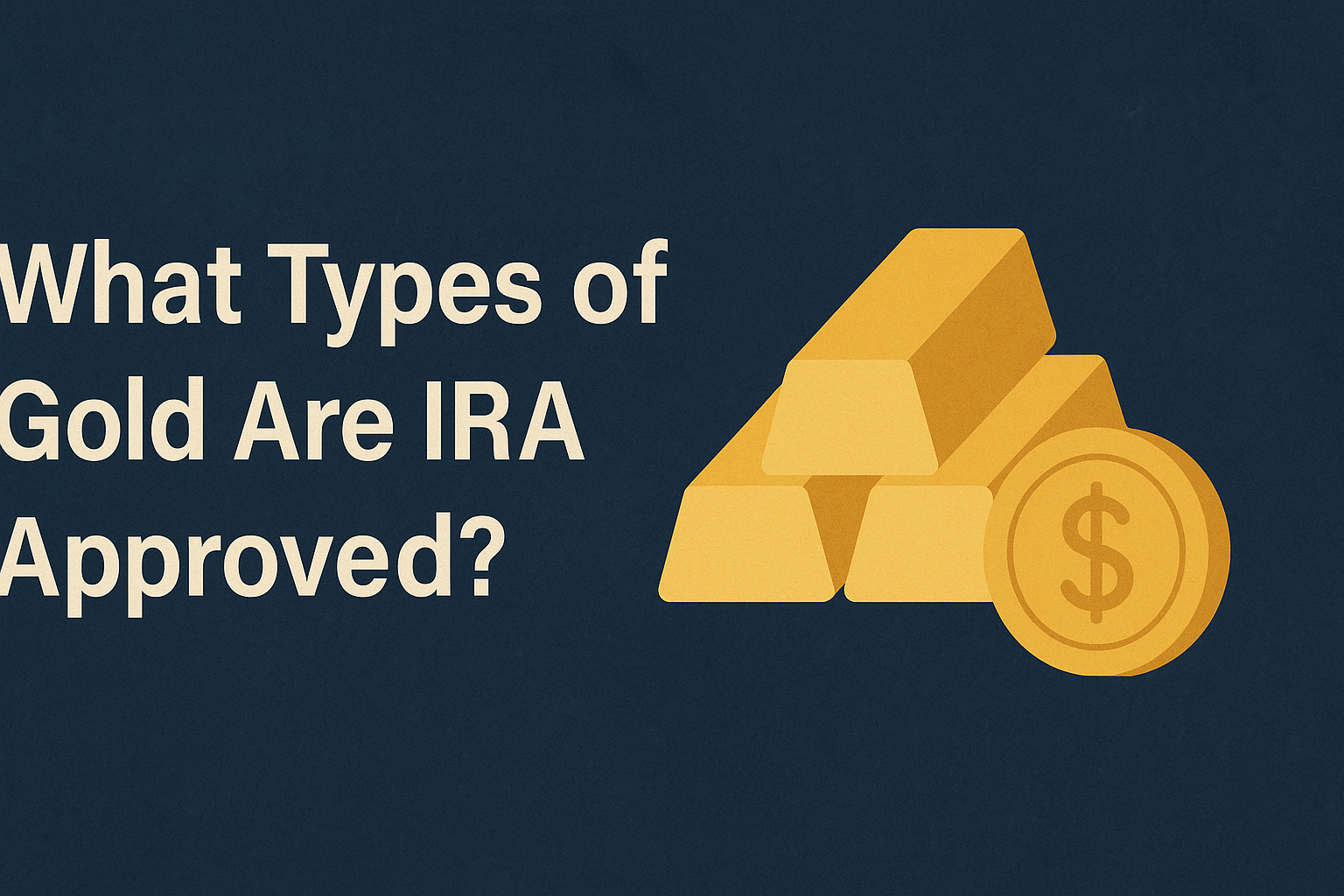If you’ve ever thought about adding some shimmer to your retirement portfolio, you’re not alone. Gold has long been a symbol of wealth, power, and security. But beyond its glittering appeal, gold offers a unique hedge against inflation, market volatility, and economic uncertainty. That’s why more and more people are looking into Gold IRAs as a way to diversify their retirement savings.
But here’s the kicker—not all gold is created equal when it comes to IRA eligibility. Before you run out to buy that shiny bar or those vintage coins, it’s crucial to understand what types of gold are IRA approved. Otherwise, you could end up with a beautiful (but disqualified) asset sitting outside of your retirement plan.
So, let’s unpack everything you need to know about IRA-approved gold—and how you can make the most informed decision for your future.
Why Gold Belongs in Your IRA
Before diving into the specifics, let’s address the “why.” Why should you even consider gold for your retirement portfolio?
Gold offers several compelling benefits:
- Inflation Hedge: Gold tends to hold its value or even increase during inflationary periods.
- Diversification: Unlike stocks and bonds, gold often behaves differently during market downturns.
- Tangible Asset: It’s a physical, durable asset—not just numbers on a screen.
- Global Demand: Gold is always in demand across the globe, making it highly liquid.
If you’re nodding along and thinking, “This makes sense,” then a Gold IRA might be worth exploring. But the IRS has very specific rules about what qualifies.
What Is a Gold IRA?

A Gold IRA, or more formally a Self-Directed IRA (SDIRA), is a type of individual retirement account that allows you to hold physical gold—as well as other precious metals—rather than just traditional paper assets like stocks or mutual funds.
Here’s what makes it different:
- Managed through a custodian or trustee who specializes in precious metals.
- You can invest in physical bullion, not just gold ETFs or mining stocks.
- All gold must meet IRS requirements for purity and authenticity.
Now, let’s get to the heart of the matter: what types of gold are actually allowed in an IRA?
IRS Requirements for Gold in an IRA
The IRS sets firm guidelines about what gold qualifies for an IRA. In short, the gold must be:
- At least 99.5% pure (with a few notable exceptions for coins).
- Produced by a recognized national government mint or an accredited refiner.
- Stored in an IRS-approved depository, not at home.
Failing to follow these rules could mean your IRA becomes disqualified—and you’ll be on the hook for taxes and penalties. No one wants that!
Let’s break down the approved types, starting with bullion bars.
1. Gold Bullion Bars
Gold bars—those rectangular chunks of gleaming metal—are often what people imagine when they think about serious investing. In a Gold IRA, bars are perfectly acceptable, as long as they meet the purity and manufacturer requirements.
✅ Must Be:
- Minimum 99.5% purity (24 karat)
- Produced by accredited refiners (e.g., LBMA, NYMEX/COMEX, ISO 9000)
Popular options include:
- PAMP Suisse Gold Bars
- Credit Suisse Gold Bars
- Royal Canadian Mint Bars
📌 Note: Always ensure your dealer provides a certificate of authenticity.
2. Gold Coins
Yes, you can include gold coins in your IRA—but only certain ones make the cut.
✅ IRA-Approved Gold Coins Include:
- American Gold Eagle Coins
- 1 oz, ½ oz, ¼ oz, and 1/10 oz sizes
- Exception to the 99.5% purity rule (91.67% pure) but still IRS-approved
- American Gold Buffalo Coins
- 99.99% pure
- First 24-karat gold coin from the U.S. Mint
- Canadian Gold Maple Leaf Coins
- 99.99% pure
- Backed by the Royal Canadian Mint
- Australian Kangaroo/Nugget Coins
- 99.99% pure
- Produced by the Perth Mint
- Austrian Philharmonic Gold Coins
- 99.99% pure
- Legal tender in Austria
❌ Not Allowed:
- South African Krugerrands
- Swiss Francs
- British Sovereigns
- Any collectible coins
3. Gold Rounds
Gold rounds resemble coins but aren’t legal tender. Because they lack government backing, most are not IRA eligible—even if they’re pure gold.
There are exceptions if they’re produced by approved refineries and meet the 99.5% purity standard, but these are rare and often scrutinized more heavily.
👉 Bottom Line: Stick to well-known coins and bars for peace of mind.
4. Commemorative and Collectible Coins
This one’s a hard no. The IRS specifically prohibits collectible coins from being included in IRAs—even if they’re made of pure gold.
That means:
- No rare coins
- No antique coins
- No limited-edition proofs
Even if a dealer swears they’re “a good investment,” if they don’t meet IRS standards, you’ll disqualify your IRA.
🚨 Pro Tip: Always consult your IRA custodian before making any purchase.
How to Buy IRA-Approved Gold
So you’re ready to move forward. What next?
Step 1: Open a Self-Directed IRA
You’ll need to work with a custodian who specializes in precious metals. They’ll help you navigate IRS rules, process paperwork, and coordinate storage.
Step 2: Fund Your Account
You can:
- Transfer from an existing IRA
- Rollover from a 401(k)
- Contribute fresh cash (within annual limits)
Step 3: Choose Your Gold
Decide whether you want coins, bars, or a mix. Your custodian can help you make a compliant selection from trusted dealers.
Step 4: Store the Gold
All gold must be stored at an IRS-approved depository. Some popular depositories include:
- Delaware Depository
- Brinks Global Services
- IDS of Texas
No, you can’t keep the gold in your safe at home—not if it’s in your IRA.
Benefits of Holding Gold in an IRA
Aside from the obvious allure of gold itself, there are some strong financial incentives:
- Tax Advantages: Depending on your IRA type (Traditional or Roth), you can defer taxes or enjoy tax-free withdrawals.
- Portfolio Balance: Gold can help cushion the blow during stock market downturns.
- Wealth Preservation: Gold has held value for centuries—making it a long-term store of wealth.
Risks and Considerations
Let’s be fair—no investment is without risks.
Gold IRA Cons:
- Fees: Custodians, storage, and insurance add cost.
- Liquidity: Physical gold isn’t as instantly tradable as stocks.
- Regulations: Must follow strict IRS rules to avoid penalties.
Final Thoughts: Is Gold Right for Your IRA?
Choosing to include gold in your retirement strategy isn’t just about trends—it’s about protecting your financial future. If you’re looking for security, diversity, and the timeless value of a tangible asset, gold might just be the right fit.
Just remember, the key is choosing IRS-approved gold: 99.5% pure bars, government-minted coins, and secure storage through a qualified custodian.
When done right, a Gold IRA can be a golden opportunity.

